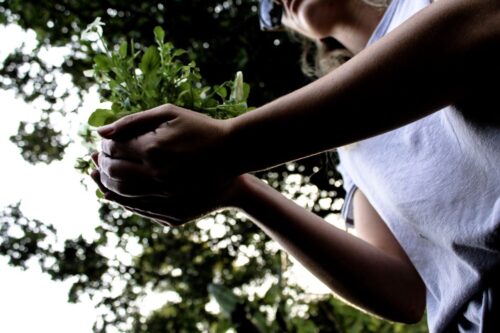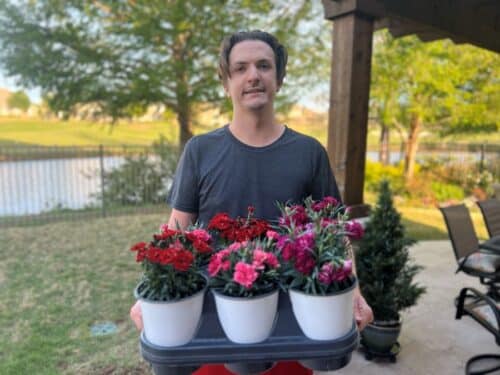Top Ways Nature Therapy Can Transform Lives of Autistics
Many people are aware of the environmental benefits of planting trees; they produce oxygen, absorb carbon dioxide, prevent soil erosion, and provide habitat for wildlife. But did you know that nature therapy in general can have positive effects for people with autism?
Nature therapy is also known as ecotherapy or green therapy and emphasizes a positive connection and gratitude between people and nature. It is based on the belief that individual’s well-being is interconnected with Mother Nature.
 Examples of nature therapy include increasing green spaces through tree planting, adding seasonal color to common areas, engaging in gardening activities, and even participating in activities in an outdoor setting such as going to dog parks with the family pet, taking walks, or riding bikes.
Examples of nature therapy include increasing green spaces through tree planting, adding seasonal color to common areas, engaging in gardening activities, and even participating in activities in an outdoor setting such as going to dog parks with the family pet, taking walks, or riding bikes.
Nature is a crucial part of our mental health; most people agree that being around nature makes you feel happier and content and more appreciative of the world. That’s why it’s important to be connected to it. Living in modern day cities can make being one with nature more difficult, as many large cities are largely pure concrete and tall buildings, void of colors and contrast, and to many, ugly.
While some people thrive in “concrete worlds” so to speak, others become anxious and depressed, when all around them is the hustle and bustle of people scurrying to offices in high rises and the sounds of horns and ambulances instead of calming nature therapy sounds. For some, the lack of “quiet” and sights, sounds, and even smells of nature can turn into mental duress over time. That’s why the simple act of planting a tree can be so healthy and therapeutic, as humans are meant to be around trees and nature.
Nature as a Therapeutic Environment for Autism
For many individuals with autism spectrum disorder (ASD), nature therapy provides a calming, sensory-friendly environment. The natural sights, sounds, textures, and smells of being outdoors can have therapeutic benefits that enhance overall health and wellbeing.
Studies show that exposure to green space can help reduce stress, lower blood pressure, and release muscle tension, while also increasing attention capacity for those with autism. The causes are complex, but certain elements of nature aid relaxation: the negative ions generated from plants and trees help purify the air and increase serotonin levels; the calming colors and textures reduce visual overload; the soothing background sounds of rustling leaves, singing birds or gentle breezes engage the auditory senses. Simply put, trees and nature create an ideal setting for centering oneself.
Access to parks, forests, gardens, and other green spaces provides invaluable opportunities for people on the spectrum to immerse themselves in these restorative landscapes. Whether it’s a shady oak tree to sit under, a meadow path to explore, or a sensory garden to stimulate the senses, contact with the natural world nurtures body and mind.
Creating more of these nature-based spaces in our communities by planting trees, from majestic redwoods in parks to saplings in backyards and school grounds, benefits society’s mental health in countless ways. For the autism community, it enhances quality of life exponentially.
Additionally, utilizing positive nature therapy can help diminish any adverse impact on autism emotions when it comes to the wrath of Mother Nature related to climate change and extreme weather events.
Planting Trees or Bushes as Meditation, Ritual and Routine Nature Therapy

Horticultural nature therapy programs are gaining popularity as interventions for children and adults on the autism spectrum for good reason. The ritualistic process of working with plants provides structure, sensory engagement, motor skills development, and a sense of purpose. For those who struggle with change and unpredictability, the orderliness of fertilizing, weeding, composting, and planting has enormous value. Caring for living things also builds empathy.
Additionally, interacting with nature helps reduce depression and worried thoughts. The “soft fascination” of a leaf fluttering to the ground or the sway of tree branches can help regulate emotions. For many facing anxiety, trees offer a symbolic sense of stability, resilience, and hope. Simply sitting still among the steadfast presence of an elder oak or proud elm provides a connection. The focused nature observation involved in tree care pulls one fully into the present moment.
Outdoor Activity, Sunlight, and Physical Exercise as Nature Therapy
Being among trees and green spaces also encourages more time outdoors, increased sunlight exposure, and physical activity—all of which can help stimulate learning and regulate emotions for people on the spectrum. The sensory richness of nature engages the mind to make critical connections. The Vitamin D absorbed by spending time outside improves mood and focus.
The physical exertion involved in gardening, climbing trees, hiking forest paths, or climbing rocky stream beds develops gross motor skills and sensory integration.
For those who struggle with short attention spans, distractibility or hyperactivity, or aggression, extended outdoor time helps avoid behaviors associated with too much indoor time spent in front of screens. Nature therapy is highly effective for individuals who are nonverbal, as no words are needed to enjoy the splendor of the outdoors.
Caregivers reap the benefits too—spending time with loved ones in nature, breathing fresh air, enjoying the sunshine, and exercising creates positive shared experiences. Planting more urban trees and increasing neighborhood green spaces makes these outdoor activities more accessible for everyone.
Trees as Calming Focal Points for Nature Therapy
For children and adults who are non-verbal or face communication challenges, trees or similar landscape-style plants can provide a focusing tool for their attention rather than becoming overwhelmed by too much sensory stimuli from their surroundings. The simplicity and stillness of a tree can be comforting amidst the complexity of navigating everyday life.
A large sturdy oak or evergreen tree can provide a centering anchor point in a park setting. Tracing the rough bark texture or finding shapes in cloud-filled branches gives one’s gaze a place to settle when feeling agitated. A favorite backyard flowering tree welcomes each season with new leaves, fragrant blossoms, ripening fruit, or migrating birds.
Watching the cycle of changes unfold year after year with the seasons instills hope. Planting trees purposefully in spaces for special needs populations, whether a quiet courtyard or playground, adds natural beauty and a calming presence.
Specific Ways to Incorporate Planting as Part of Nature Therapy

- At schools, have students participate in beautification efforts around campus, such as planting trees, shrubs, or even perennials. This teaches them about biology and ecology while providing a sensory-rich experience. Have them research and select plants that will thrive in your climate. Digging holes, transporting saplings or plants, mulching and watering around the roots are all engaging hands-on activities.
Assign students to “adopt” a plant to care for. Watching their tree or plant grow over the years creates ownership.
- Local parks departments could organize volunteers in the community tree planting days specifically for families affected by autism. Make it a fun outdoor event with music, games, and environmental education.
Have various stations for kids to pot tree saplings to take home. Provide calming sensory experiences like leaf rubbings. Make it joyful and encourage connections.
- Increase funding at therapy centers, schools, and group homes to install sensory gardens featuring many trees. These spaces provide safe greenery for outdoor time.
Features like textured bark pathways, wind chimes, bird feeders, and garden beds give users many ways to engage their senses. The garden’s trees also block excess sun, noise, and commotion.
- Adult vocational training programs can teach tree care skills as a way to calm the mind, build confidence, and provide transitional employment.
Tasks like watering, pruning, mulching, and raking leaves around public trees help communities while benefiting program participants. Securing jobs with landscaping companies to care for trees and even designing landscapes as a creative outlet are possibilities.
- Families can plant trees together in their yards to provide special spots for relaxation and play. Have siblings research the best types of trees for your area, then visit a nursery to select the perfect sapling or plant of choice.
Decorate a miniature pot as the tree’s “home” until you’re ready to place it in the ground. Make planting day special.
The options are endless! With some creativity and planning, the lives of people with autism can be enriched by intentionally incorporating nature therapy experiences into programming, infrastructure, and daily routines.
The benefits for physical health, sensory processing, vocational skills and emotional regulation make it well worth the effort.
Bringing the Benefits of Nature Indoors
While spending time outdoors among trees is ideal, it’s not always possible for people with autism who are in classroom or residential settings. Here are some creative ways to bring the benefits of nature indoors:
- Decorate sensory rooms or quiet spaces with large nature photography prints depicting lush forests, trees, and plants. This creates a relaxing ambiance and helps focus attention.
- Incorporate textured tree bark rubbings into tactile sensory bins. Bark has unique ridges and grooves to trace with fingers. Pair with leaves, acorns and tree cookies.
- Make DIY ‘wind chimes’ using fallen sticks and leaves. Suspend them near windows where breezes outside create soothing sounds inside. Add chimes outdoors too.
- Display a large floor puzzle showing a forest ecosystem mural. Assembling it provides cognitive engagement.
- Help students create dioramas inside cardboard boxes depicting forest scenes. Use natural items like moss, pinecones and sticks for pretend play.
- Simulate the sensory experience of being under a shady tree using a canopy frame over a mat with images of leaves. Play nature sounds. Offer textured cushions and green blankets.
- Grow indoor plants and small trees if possible to bring the outdoors in. Caring for them teaches responsibility.
- Grow a butterfly garden, plan a terrarium or aquarium, or make a succulent area.
- Use an essential oil diffuser with organic eucalyptus, pine, or cedar oils to remind us of time spent in nature.
- Make DIY bird feeders to hang near windows and observe activity.
- Get creative with lights, sounds, fabrics, accessories, and more to recreate the sights, smells, textures, and sounds of being among trees and forests. This form of nature therapy engages the senses, calms the mind, and provides connections to nature while indoors. Every little bit counts when it comes to enjoying the benefits!
- Watch a movie about farming or specials about our rainforests or different types of terrains.
- Teach students all about nature and its various elements.
Improving Our World for All Through Nature Therapy

The simple act of digging holes and planting something that will grow and bring happiness at schools, rehabilitation centers, group homes, and parks can have profound effects. Trees planted today become shady gathering spots for future generations.
Trees and greenbelt areas improve the quality of life for all communities. For the autism community, open and engaging green spaces typically enhance mental and physical well-being exponentially. Nature therapy is a win-win proposition for improving our world by making it greener, healthier and more inclusive.
Let’s get together and start planting!
Increase Your Understanding of ASD By Learning About Common Autistic Behaviors
There are many behaviors associated with having autism. Keep in mind that everyone presents differently, which is why it is caused by a spectrum disorder. However, there are common autism behaviors. Learn more about them.
- Autism and Apraxia: Why The Connection Can Be Surprising
- Autism and Eye Rolling: Why It’s Odd, But Perfectly Okay
- Eye Contact Avoidance: 8 Best Ways to See Eye to Eye
- 10 Proven Techniques for Managing Autism and Sensory Issues
- Autism and Sleep Disorders: Top 4 Reason for Sleepless Nights
- Understanding Neurodiversity: Uprising of the Neurodivergent
- Autism and ADHD: Making Sense of the Overlap
- Autism Masking & Code Switching: How to Redefine Acceptance
- Autistic Stimming Behaviors: Why We Do and How It’s Important
- OCD and Autism: Could You Have One Condition or Both?
- Autism in Sports: Hyper-Focus Can Be A Commanding Competitive Advantage
- The Truth About Autism Lack of Empathy Disorder Needs to Be Told
- Startling Insights About Autism and Depression